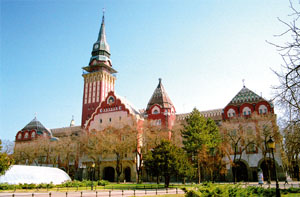

Subotica is a city located in the very north of Vojvodina, which itself is located in northern Serbia. The city is well known for its many great examples of Hungarian architecture (mostly secessionist style, a type of Art Nouveau; late XIX to early XX century, but also other styles), and a lively student scene, as well as many festivals of various types. The city is multicultural (Hungarian/Serbian/Croatian) and thus has a very unique flavor of culture. In its vicinity are the lake and lakeside town Palić, popular among tourists from the region.
Get in
Subotica is accessible from both Belgrade and Budapest by the fast international train (Subotica is located on its route), that starts its journey from Prague and travels to Belgrade (and vice versa). Via these cities Subotica is connected to most European capitals by train.
There are also direct trains running to and from Novi Sad. Serbian Railways timetable/schedule can be seen here.
There are also 2 daily direct trains from Szeged just across the Hungarian border. This train takes 2 hours, but only goes 45km, and costs under 200 Dinar (~2€). It is a single carriage local train and quite an experience.
A1 motorway (E75), Serbia's longest and most important road, passes through the city limits, if you prefer travel by car. For calculating travel times by car you can use this site.
Buses are also an option (for example direct ones from Novi Sad, Belgrade, Budapest, Zagreb, Szeged, Sombor). They are usually more expensive but are also, more often than not, faster, cleaner and more comfortable than most local trains, and thus definitely recommended unless you want to experience the more unique domestic experience. Timetable.
Subotica doesn't have an intercity airport, so if you're traveling directly to Subotica from a larger distance you will first have to fly to another bigger city. The nearest airports are the Nikola Tesla International Airport (BEG IATA) [1] near Belgrade (about 180 km by road/2 hours) and Budapest Ferihegy International Airport (BUD IATA) [2] (200 km by road/2 hours). There's also less recommended Timisoara Traian Vuia International Airport (160 km by road but 3 hours).
Understand
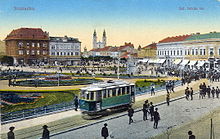
Subotica reached its golden period during the beginning of the XX century, when the majority of its monumental buildings were built. It was a very important center of wealth, influence and culture. It was the third largest city in the Kingdom of Hungary and subsequently the third largest city in the newly formed Kingdom of Yugoslavia (after Belgrade and Zagreb). As chance would have, having become a border-city its population growth stopped and stagnated at the same number ever since, and now it's only the second largest city in Vojvodina (after Novi Sad) and fifth in Serbia. Because of this, today, Subotica is not a huge city population-wise, and is free of the typical congestion and concrete-jungle feel of bigger cities, but it still nonetheless has a disproportionate amount of beauty to offer and a relaxed pleasant atmosphere. One of the things that hasn't changed over the decades though is its multicultural nature (1/3 Hungarian, 1/3 Serbian, 1/3 Croatian, though the city's Jews were murdered during the Nazi occupation and its Germans mostly left after WW2), with all the benefits that come with it, among them a unique and vibrant culture.
Talk

There are two languages in everyday use in Subotica: Serbo-Croatian(Serbian/Croatian) and Hungarian. The former is spoken by nearly everyone, while the latter is spoken natively by ethnic Hungarians who make up around 35% of the city's population and is also understood/spoken by many others to varying degrees. When it comes to global languages most younger people speak at least some English (many are fluent), but when it comes to older generations (60+) German is more useful. Your best bet with middle-aged people is also English (don't expect fluency).
Get around
A detailed map of Subotica can be downloaded from here.
Most of the city's important sights are more or less within walking distance of each other (which is also the best mode of travel through the city for appreciating the architecture and atmosphere). Lake town Palić is accessible by public transport (bus; number 6, stops near Hotel Patria, near the city center). The city bus timetables are available here. A single ticket costs 60 dinars. In a "double-bus" you buy the tickets at the back, in a "single-bus" you buy them at the front, from the driver (or just follow the crowd if there are other people). In case you decide you need a cab (to see some stuff on the other site of town for example, or for whatever reason) there are taxi stations on many locations but the easiest to find for a tourist are probably the one next to the Town Hall and the one next to the train station. Taxis are not overly expensive by Western standards. Make sure the taximeter is on.
If you're in shape you can rent one of the 56 bikes available in 4 parking-points.
See
Subotica's beautiful town hall is surrounded with a number of pedestrian-only streets where people gather and meet, especially in the evening, giving the town a Mediterranean feel. The water-fountains and cafes in the center of the town are a great spot for people watching. The townhouse itself is lit up at night with spotlights that highlight the beauty of the building. It's also surrounded by a small park (the city center is generally rich with vegetation and trees) in which one of the two big fountains is located. There are several galleries. A tour through the Town Hall is also worth doing. There are also many beautiful religious buildings worth seeing.
Squares
- Main Square - Liberty Square, Trg slobode. Unlike many European towns, in Subotica the City Hall dominates the city centre instead of a church or a cathedral. The City Hall is a master peace of Hungarian version of Art Nouveau built in 1912. It is flanked by a park with a fountain and a vast square where many concerts and bazaars are organized throughout the year. It is surrounded by the building of People's Theatre that is undergoing a major reconstruction. Originally it was a classic style building characterized by six Corinthian columns. On the Eastern side of the square there is a neo-baroque building of The Public Library. The two Atlases carrying one of the nicest balconies in the city make this building charming. The Emperor Jovan Nenad Monument in the middle of the square represents a controversial historical figure. He styled himself emperor and pronounced Subotica his capital in 1527, but all lasted for a very short period of time. Not far from the monument there are two ceramic fountains. The Green Fountain (1985) and the Blue Fountain (2001) are the pearls of the city centre. Both were made of Zsolnay tiles, likewise all decorative ceramics and roof tiles of the city’s Art Nouveau buildings.
- Cathedral Square, Trg Sv. Terezije. The Cathedral, that dominates the square, was built in late baroque style in 1779. It is dedicated to the patron saint of Subotica, St. Theresa of Avila. The bell towers are 64 m high. It has valuable altar paintings and organs. On the same square lies the monument to the Victims of Fascism. It is 18 meters wide and 8 meters high what makes it the largest monument in Subotica. In front of the monument there is a rest area with a small fountain and a sculpture the Hands made by a local artist. Opposite to the monument is the Lifka Art Cinema and Kosztolány Dezső Theatre that produce plenitude of cultural events.
- Prozivka Square/Park
Art Nouveau Architecture
- The City Hall, Trg slobode 1, ☏ +381 24 67 20 20. The City Hall was built between 1908 and 1912. The decorative features of Art Nouveau are enriched with a romantic nuance of the Hungarian folklore, by floral elements made of ceramics and wrought ironwork forging. The Council Hall and its splendid stained glass windows are the heart of the building. Building’s 45 m high observatory provides an unforgettable sight of Subotica and its outskirts. Visiting hours: Individual tourists Tuesday to Friday at 12 am; groups by appointment.
- Synagogue, Trg sinagoge 2, ☏ +381 24 533 797, +381 63 11 533 20. Built in 1902, it is one of the finest surviving pieces of religious architecture in the Art Nouveau style in Europe. It is decorated by stylized tulips, carnations and peacock feathers that are typical of the Hungarian version of the style. With daring and modern architectural solutions, it perfectly harmonizes structure and decoration. Visiting hours: by appointment or from March till October on Saturdays from 10 am till 2 pm
- Raichle Palace, Park Ferenca Rajhla 5, ☏ +381 24 553 725. It was built in 1904 by the architect Ferenc Raichle to be his home and his design studio. Expensive materials, the unusual combination of colours, the vibrancy of forms, the lavish interior and the backyard make this sumptuous house an exceptional example of the Art Nouveau architecture. At present, it hosts the Modern Art Gallery “Likovni susret”. From Monday to Friday: 8-19h and Saturday from 9 to 13 h
- Women's Lido, Obala Lajoša Vermeša bb, Palić. This, another magnificent example of Hungarian Art Nouveau style building, extends out into the lake. The fairytale-like wooden Women’s Lido is rich in details and reminiscent of folk art. The unusual architecture of this building, intended for rest and relaxation still, after a hundred years, attracts visitors to stop by and have a look
- Water Tower, Horgoški put bb, Palić. The architects of the building had the idea of entering the Grand Park and resort through lavishly decorated entrance – The Water Tower. It was designed in Hungarian Art Nouveau style, inspired by folk elements: handicrafts, laces and embroidery. This symbol of Palić was formally open in 1912. The architects Komor and Jakab designed the City Hall and the Synagogue in Subotica, the Grand Terrace and the Women's Lido in Palić.
- Dömötör Palace - The City Museum, Trg sinagoge 3, ☏ +381 24 555 128. Tuesday to Saturday from 10 am to 6 pm. The City Museum is situated in the Dömötör family house built in the style of Darmstadt Art Nouveau. It was designed by the Vágó brothers in 1906. Their works had always been decorated with the motive of two birds, which is present on this facade, too.
- Former Subotica Savings Bank, Korzo 4. This building was designed by M. Komor and D. Jakab who, after completing one big commission (the Synagogue), were waiting for the new one (the City Hall). Designed also in Hungarian version of the style, it was built in 1908 for the Subotica Savings Bank. Because of its function, many corresponding symbols can be found on the facade. Squirrel – symbol of diligence, beehive - symbol of thrift, owl – symbol of wisdom.
- Former Golden Lamb Hotel, Korzo 3. Example of the Munich Art Nouveau (Jugendstil) in Subotica is the building number 3 in the Korzo Street. The facade of the 19th century the Golden Lamb Hotel was adapted in 1904 by the local architect Titus Mačković. In the 80s it was pulled down and built as it once looked like.
- Former Town's Tenement Building, Nušićeva 2. The architect, Pál Vadász although being the creator of the genuine geometric Viennese Secession in Subotica, designed this building in simple, almost modern concept in 1913. This was a tenement building and it was commissioned by the Council of Subotica.
- Leović Palace, Park Ferenca Rajhla 11. In 1893, by construction of this building the new architecture style stepped into Subotica. Some of the characteristics of the new style such as rejecting old forms, human proportions, asymmetry, new materials etc – can be found here.
Museums and Galleries


- Municipal Museum - Dömötör Palace, Trg sinagoge 3, ☏ +381 24 555 128. It is a complex museum with archaeological, ethnographic, historical, art and natural collections and a collection of bequests. Today the museum awaits visitors with seasonal exhibitions, while the permanent exhibition is under construction. This Art Nouveau building, was restored in 2008 by the local government to fit the needs and purposes of the museum. Opening times: Tuesday to Saturday from 10 am to 6 pm
- Modern Art Gallery Likovni susret - Raichle Palace, Park Ferenca Rajhla 5, ☏ +381 24 553 725. Modern Art Gallery was founded in 1962. It safeguards more than 1200 works of art of the most prominent artists from the former Yugoslavia of the second part of the 20th century – paintings, graphic works, sculptures and ceramics. The gallery produces solo and collective exhibitions, artists' performances and other artistic events. It is situated in an exciting venue – the Raichle palace. FromMonday to Friday: 8-19h and Saturday from 9 to 13 h
- Open University Gallery, Trg cara Jovana Nenada 15, ☏ +381 24 554 600. from 8 am to 8 pm. The gallery had the privilege to host many eminent artists from the whole Serbia and also many ensembles of international artists during the International Children's Festival and also during the Palić European Film Festival.
- Native gallery Dr Vinko Perčić, Maksima Gorkog 22, ☏ +381 24 559 063. This gallery features presentations of visual artists of various art practice: painting, sculpture, graphics, multimedia, performance, etc... It also exhibits art objects, the legacy of Subotica's doctor of medicine Vinko Perčić. Monday to Friday from 7 am to 2 pm or during temporary exhibitions from 9 am to 1 pm and 5 pm to 7 pm.
- Straw Art Gallery, M. Oreškovića 3, Donji Tavankut. for group and individual visits – by appointment. Straw-work art is a unique naive folk art that is fostered in Subotica and its region. The Straw-work Art Colony has been organized in Tavakut near Subotica since 1986. Some of the straw-works made during these colonies are displayed in the Gallery. Except for the permanent exhibition, gallery organizes exhibitions to popularize this art technique. The gallery is located in an authentic village house in the center of Donji Tavankut which is 17 km from Subotica.
Sacral Buildings
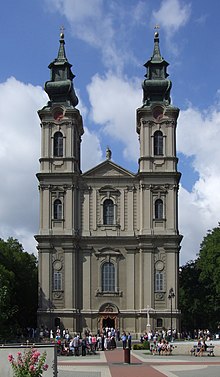

- Catholic Cathedral of St. Theresa of Avila, Trg Sv. Terezije 1, ☏ +381 24 600 240. The Cathedral was built in late baroque style and is dedicated to the patron saint of Subotica, St. Theresa of Avila, whose figure appears in the city’s coat-of-arms as well. It was built in 1779 and has been renovated several times since then. In 1974, the Pope awarded the church with the title of a smaller basilica. Visiting hours: 6:30 am- 12 am and 5:30pm- 8:40 pm
- Franciscan Church, Trg franjevaca 13, ☏ +381 24 551 256. This Church dedicated to St. Michael the Archangel was built in 1736, on the ruins of the medieval fortress from the 15th century. Attached to it is a friary with a chapel dedicated to the votive painting, the Black Madonna. The church, classified as a neo-Romanticism building, is part of the Franciscan monastery. Visiting times: Church is open at all prayer times.
- Serb Orthodox Church, Zmaj Jovina 22, ☏ +381 24 522 590. The baroque Church was built in 1726, on the highest part of the old city. In 1910, the new tower and the new iconostasis were added. The Church is dedicated to the Holy Ascension. Visiting times: Church is open at all prayer times.
- Senćanska crkva Svetog Đurđa, Борска ulica. The church was built in 1897 in neo-Gothic style and even though it's outside the city center proper by many it's considered the prettiest church in Subotica.
- Muhajir Mosque, Karađorđev put 62, ☏ +381 24 52 80 77. This Muhajir Mosque is the first Islamic building that was built on the main road from Sofia to Budapest in the last two centuries (2008). It is a harmonious building with a dome and a 25m high minaret. The mosque is open at all prayer times.
- Small Synagogue near The Synagogue, Dimitrija Tucovića 11, ☏ +381 24 670 970. The buildings of the Jewish Community houses the small synagogue at the ground floor. Originally it was a winter synagogue. It is nicely decorated with a meticulous wall painting. Stained glass windows with a representation of Noah's doves of peace, dominates the place. The temple is open for Sabbath services and other holidays. Visiting time: the temple is open for Sabbath services and other holidays.
- Serb Orthodox Church in Aleksandrovo, Beogradski put 159, ☏ +381 24 566 122. This small church, dedicated to St. Dimitrius is located in the suburb of the city. There is an iconostasis, the region’s first art work and the first baroque iconostasis in Serbia. The iconostasis was moved to this church in 1909 from the Orthodox Church in Subotica.
- Pilgrimige Site in Aleksandrovo, Aleksandrovo salaši 124, ☏ +381 (0) 24 566 546 (Catholic Church), +381 (0) 24 566 122 (Orthodox Church). The site is on the South-West bank of the lake Palić and is a place of pilgrimage for both the Roman Catholic and Serb Orthodox believers, hence it has more names: Bunarić (Croat), Szentkút (Hungarian) and Vodice (Serbian) – meaning a little spring or a well. In a nicely landscaped park, there are two small chapels, which can be visited through the year, thus the biggest pilgrimages take place at the end of August.
Theatres & Cinemas
- National Theathre, Park Ferenca Rajhla 12, ☏ +381 24 557 436. The National Theatre fosters cultural identity of all national communities in Subotica and it is an unique theater in our country because it has two ensembles: one that plays in Serbian and the other that plays in Hungarian language. In terms of repertoire, it tries to satisfy the diverse interests of the audience of different ages. Both ensembles play on Jadran stage till the completion of the theatre building. Ticket office: Everyday from 10 am to1 pm and from 6 pm to 7:30 pm.
- Kosztolányi Dezső Theatre, Trg žrtava fašizma 5, ☏ +381 24 557 471. Kosztolány Dezső is devoted to producing alternative theatre. From Shakespeare to Mrozek, from Beckett to Brecht. Each new performance brings an entirely different experience. Ticket office: from 10 am to1 pm and from 5:30 pm to 7:30 pm.
- Lifka Art Cinema, Trg žrtava fašizma 5, ☏ +381 24 531 991. Art Cinema Alexander Lifka fosters the European cultural orientation of Aleksandar Lifka, a pioneer of cinematography in this region. Beside artistic and documentary movies, box-office movies are shown in the cinema, too. Ticket office: half an hour before the movie show.
- Eurocinema, Trg cara Jovana Nenada 15, ☏ +381 24 554 600. EuroCinema has on its repertoire mostly European films including Serbian ones and the award-winning productions at prestigious European film festivals. Beside that some box-office films are occasionally shown in the cinema, too. Ticket office: Everyday from 8 am - 8 pm.
- Children's Theatre (and The Athletes' Centre)
Do
The town comes alive at night. The street Matija Korvina (off the main pedestrian street "Korzo") seems like the most happening, with a number of popular bars and restaurants (Boss, Stara, Beer&Co). In the summer there are many festivals of music, film, food, and any other excuse creative people can find. There is a large market about 2km west of the center called "Buvljak" or "Ocskapiac" (meaning flea market), where a morning can be gone in a flash. 8km to the east is Palić, an idyllic lakeside town of 6,000 people (take bus no. 6 to get there). The parks surrounding the lake are popular with tourists from the region. There's also a very green and well kept Zoo located in the parks (by all accounts the best in Serbia). There's also a big traditional horse farm/stables/range near Kelebija (a couple of kilometers from Subotica) for those interested in experiencing and ridding in traditional horse carriages.
Buy
There are many large supermarkets scattered around the city. There's also a large mall located in a street off the main square. For a more unique experience visit the city's main large market about 2km west of the center called "Buvljak" or "Ocskapiac" (meaning flea market), where a morning can be gone in a flash.
Eat


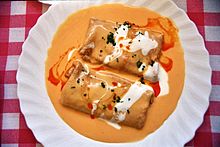
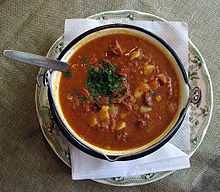
The local dishes are definitely worth seeking out, as they are done really well and are quite cheap as well.
The region's famous fast-food is Burek. It is a pastry with various fillings like cheese, mince, mushroom, etc. It costs about 100 dinars (1 euro), a bit more with "(tekući) jogurt" (a liquid form of savoury yoghurt). Most bakeries will have it, as well as specialized shops where it is made in front of you. An experience not to be missed!
Some other domestic fast-foods are pljeskavica (roughly pronounced as plyeskaveetsa; basically a kind of Serbian hamburger) and palačinke (palachinkeh; European pancakes/crêpes filled with either savory or sweet stuffing, folded in fat/wide rectangles). The savory stuffing can for example be chicken, vegetables and sour cream or for example cooked minced meat plus cream and bolognese sauce. Sweet can be nutella, whipped cream and cookie crumbs. There are "to-go/in-hand" fast-food variants and also restaurant variants.
Also worth seeking out is "ćevapi" (chevapi), small skinless sausages served in a flat bread called "lepinja".
Grilled or barbecued meats are also a tradition, so they are done masterfully. Look for places displaying the sign "Roštilj".
Also don't leave the city without trying gulaš and paprikaš (traditionally Hungarian, and just generally local, types of meat stews) popular among the locals.
If looking for full service, an upmarket ambiance and international menu, check out Boss Cafe in the center of town; is a really nice place to spend time and the pizza is excellent. (http://www.bosscaffe.com/)
Drink
Since the region grows a lot of fruit, a lot of households make snaps ("Rakija") from the various stone fruit, apples, pears, grapes, etc. grown locally. Try to find some that was made for own consumption (and not for sale) for the best quality! Another local specialty is a bitter herbal liqueur called "Gorki List" (various knock-offs are called Pelinkovac, as they are all made from the herb called Pelin, but this is the real deal). It aids digestion, so drink it some time before the meal. There are also traditional wineries near the city if you prefer wine.
Sleep
Hotels:
Hotel Galleria****
Hotel Patria****
Hotel Best Western - Gloria****
Hotel Vila Majur****
Hostels/Motels:
Vila Royal Crown****
Mecosano****
Evropa****
Gat***
Aleksander A***
Mali Hotel***
Vila Inn**
Denis**
Konak Ljutovo**
There is a hostel with clean modern private rooms for 900 Dinar per night. It is behind the station, Segedenski, behind the Economics Faculty at number 14. The tourist information can supply maps and directions too.
Go next
If you haven't already included it in your Subotica visit go check out the nearby lake and lake-town Palić (bus n.6). Otherwise take Bus n.1 (in front of the train station) to Kelebija granica (the Hungarian border). From the border you can walk to Tompa Bus station and take buses from there to Szeged, Pécs (via Baja) and Kiskunhalas. Due south is Novi Sad and southwest is Sombor if you plan to stay within Serbia.
